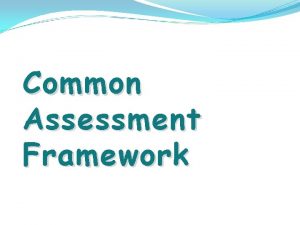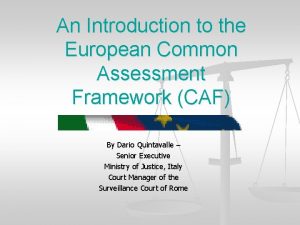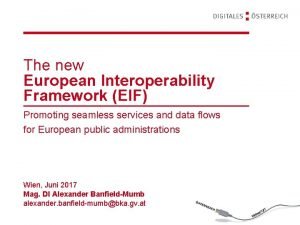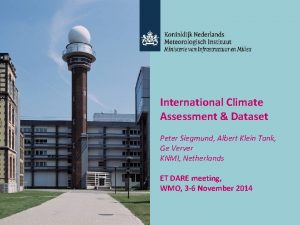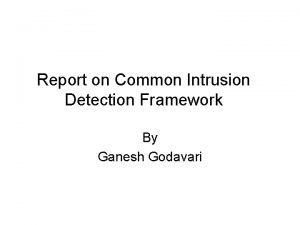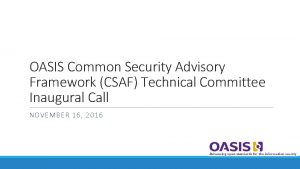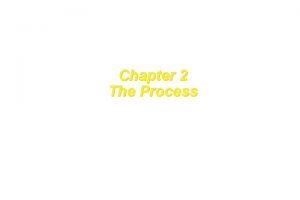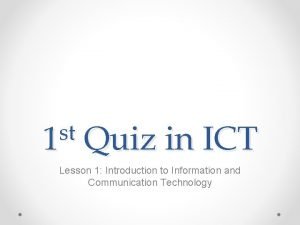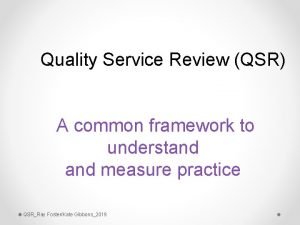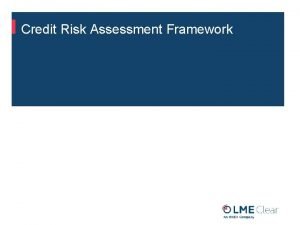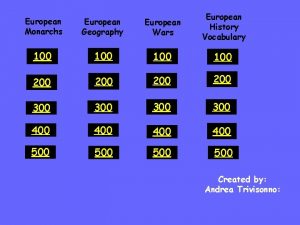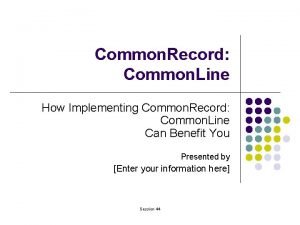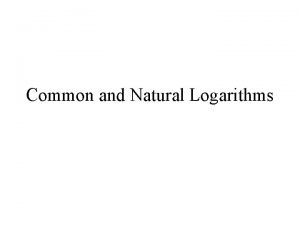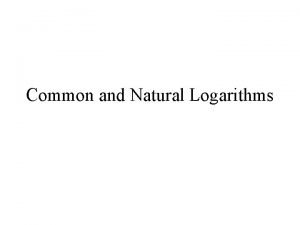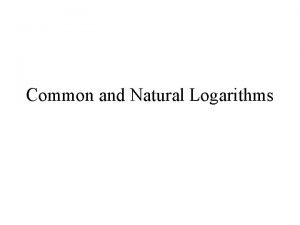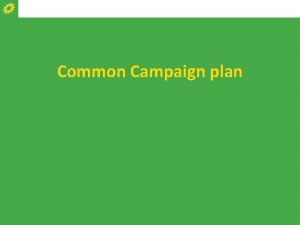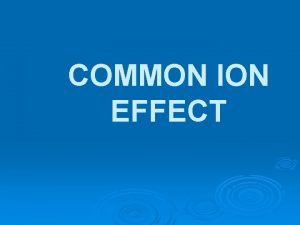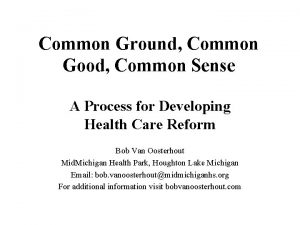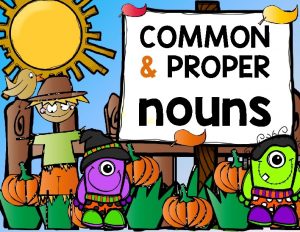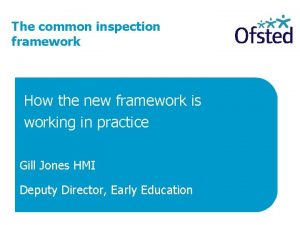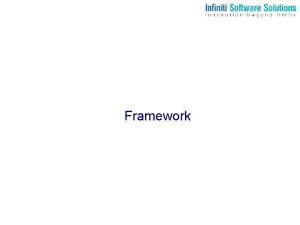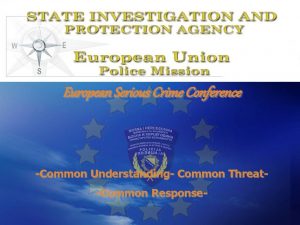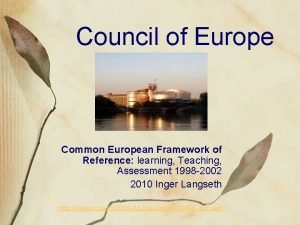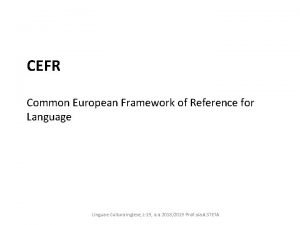An Introduction to the European Common Assessment Framework











































- Slides: 43

An Introduction to the European Common Assessment Framework (CAF) By Dario Quintavalle – Senior Executive Ministry of Justice, Italy Court Manager of the Surveillance Court of Rome

Introduction n n n What is CAF Why is good for us The PDCA cycle Enablers and results Scoring The CAF trip Exercise of selfassessment

CAF, What is it? n n n The CAF is an easy-to-use, free tool to assist publicsector organizations across Europe in using quality management techniques to improve their performance. The CAF is a total quality management (TQM) tool It is inspired by the major Total Quality models in general, and by the Excellence Model of the European Foundation for Quality Management (EFQM) in particular. It is especially designed for public-sector organizations, taking into account their characteristics. Its application to Justice were first experimented in the Surveillance Court of Rome.

CAF purposes: n n n To introduce public administrations to the principles of TQM and gradually guide them, through the use and understanding of self-assessment, from the current “Plan-Do” sequence of activities to a full fledged “Plan. Do-Check-Act (PCDA)” cycle; To facilitate the self-assessment of a public organization in order to arrive at a diagnosis and improvement actions; To act as a bridge across the various models used in quality management; To facilitate bench learning between public-sector organizations.

Key aims and principles of the CAF Aims A standard European approach Principles A process supported by a standard form Assessment to support earlier intervention Holistic Improve joint working and communication Focuses on needs and strengths Support the sharing of information Simple and practical Rationalise assessments Empowering and a joint process Help improvement CAF cannot guarantee service provision

CAF helps you: n n Effective identification of the strengths of the organization and the areas where improvement is needed Identification of relevant improvement actions Increased level of awareness and communication throughout the organization to make your people become aware and interested in quality issues

Total Quality in the organization n n Quality of results = Quality of organization Two management models n n ISO 9000 (housekeeping - employees) “DO THINGS RIGHT” TQM (continuous improvement - top management) “DO THE RIGHT THING”

PDCA Act Plan Check Do

PDCA n n n PLAN: define objectives you want to achieve, considering your customers DO: execute your plans, monitoring indicators CHECK: assess your achievements, comparing them with your objectives. Success / failure ACT: correct, revise, reconsider, improve, consolidate = Heuristics: solve problems by learning and discovery

Key words n n n Quality Improvement Communication (critical success factor ) Communication ( Self-consciousness Learning organization

Self - assessment n n n “Check first: learn about yourself – Why? Incentive your HR listening them You get impressions, not only data You focus on the citizen as a protagonist You add value from existing competencies You get info you could only get n a market system

Enablers / Results ACT Plan, Do, Check

Emphasis on Leadership n n It is different from a managerial position Manager: has defined responsibilities, operates in predictable environments, on a daily basis Leader: a creative vision of the future, a driving force for change, a talentscout, adds value to the whole ensemble Involves, promotes, delegates

You always have a choice… n n 1. 2. 3. In public administrations, WHAT to do is defined by laws… But it is up to you to decide HOW to do it Focus on vision and mission Attention to client and stakeholders’ needs Translate into achievable goals and strategies

Other enablers n n n Personnel: Your Human Resources, a hidden treasury (Internal Synergy) Partnership: those who can help you and have interest in your success (External Synergy) Processes: actions organized and finalized to a scope

Results n n n Output: Processes deliver OUTPUTS. In other words, what pops out of the end of a process is an output. Outputs are concrete and measurable. Outcomes: Outputs are produced because there is a customer of the process who wants them. Customers usually have expectations about both the process and the output (how they get what they want, and what they actually get). An OUTCOME is a level of performance, or achievement. It may be associated with the process, or the output. Outcomes imply quantification of performance. Impact: non-intended results

Results criteria n n Citizen-oriented Personnel-oriented Society-oriented Key performance – oriented

1. Leadership n n n Assessment: Consider evidence of what the organization is doing to: 1. 1. Provide direction for the Court by developing its mission, vision and values. 1. 2 Develop and implement a system for the management of the Court organization, performance and change 1. 3. Motivate and support people in the Court and act as a role model 1. 4. Manage the relations with politicians and other stakeholders in order to ensure shared responsibility

2. Strategy and planning n n n Assessment: Consider evidence of what the organization is doing to: 2. 1. Gather information relating to the present and future needs of stakeholders 2. 2. Develop, review and update strategy and planning taking into account the needs of stakeholders and available resources. 2. 3. Implement strategy and planning in the whole organization 2. 4. Plan, implement and review modernization and innovation

3. People n Assessment: Consider evidence on what the organization is doing to: 3. 1. Plan, manage and improve human resources transparently with regard to strategy and planning 3. 2. Identify, develop and use competencies of employees, aligning individual and organizational goals 3. 3. Involve employees by developing open dialogue and empowerment

3. People n n Judges and Court Clerks: a pyramid or a team? Respect, dialogue, empowerment: a safe and healthy environment

4: Partnerships and resources n n n n How the organization plans and manages its key partnerships? 4. 1. Develop and implement key partnership relations 4. 2. Develop and implement partnerships with the citizens/customers 4. 4. Manage information and knowledge 4. 3. Manage Finances 4. 5. Manage Technology 4. 6. Manage facilities

5: Processes n n How the organization identifies, manages, improves and develops its key processes in order to support strategy and planning? 5. 1. Identify, design, manage and improve processes on an ongoing basis 5. 2. Develop and deliver citizen/customer oriented services and products 5. 3. Innovate processes involving citizens/customers

6. Citizen/customer-oriented results n n n what results the organization has achieved to meet the needs and expectations of citizens and customers? 6. 1. Results of citizen/customer satisfaction measurements 6. 2. citizen/customer-orientation measurements

7: People (HR) results n n n What results the organization is achieving in relation to the competence, motivation, satisfaction and performance of its people. 7. 1. Results of people satisfaction and motivation measurements (welfare) 7. 2. Indicators of people results (satisfaction, productivity, skills development, mobility)

8: Society results n n n The results the Court is achieving in satisfying the needs and the expectations of the local community. 8. 1. Results perceived by the stakeholders (e. g. : reputation) 8. 2. Indicators of societal performance established by the Court (e. g. : amount of media coverage)

9: Key performance results n n 9. 1. External results: The results the Court is achieving with regard to the needs and demands of the different stakeholders 9. 2. Internal results: results the organization has achieved in relation to its management and improvement

SCORING n n IMPROVEMENT is the scope of CAF The way to improve is self-assessment (check) The output of a self-assessment process is to have a framework of WEAKNESSESS and CAUSES. Scoring helps defining priorities

Results first! “Results” are objective data and have a quantitative measurement n Results are symptoms, the problem is in Enablers n

How to score “Enablers” We are not active 0 - 10 Plan We plan to do this 11 -30 Do We are doing it Check We check what we 51 -70 are doing We adjust if 71 -90 necessary We are 91 -100 continuously improving Act PDCA 31 -50

How to score “Enablers” n n Choose the level that you have reached: Plan, Do, Check or Act. Give a score between 0 and 100 according to the level that you have reached inside the phase. The scale on 100 allows you to specify the degree of deployment and implementation of the approach.

How to score “Results” Trends / Target No results measured Negative trends /don’t meet targets Flat trends/ some targets are met Improving trends /most targets are met 0 - 10 11 -30 31 -50 51 -70 Substantial progress /most of relevant 71 -90 targets are met Excellent + sustained results/ all targets met/positive comparison with other Courts 91 -100

How to score “Results” n n Give a score between 0 and 100 for each sub criterion on a scale divided in 6 levels (corresponding to the results panel of the CAF 2002). For each level, you can take into account either the TREND, either the ACHIEVEMENT of the target or both.

Note on scoring… n n Pease note that this is the simplified 2002 scoring system. It is good to start. A more sophisticated scoring system was defined in 2006 And now start the process…

1. Start the trip…. n n n Step 1 Decide how to organize and plan the self-assessment (SA) Assure a clear management decision in consultation with the organization Define the scope and the approach of the SA Choose the scoring panel Appoint a project leader

2. Communicate… n n Step 2 Communicate the selfassessment project Define and implement a communication plan Stimulate involvement of the staff in the SA Communicate during the different phases to all the stakeholders

3. Compose a group n n n Step 3 Compose one or more selfassessment groups Decide on the number of self assessment groups Create a self assessment group that is relevant for the whole organization in all its aspects, respecting a set of criteria Choose the chair of the group(s) Decide if the manager should be part of the selfassessment group

4. training n n n Step 4 Organize training Organize information and training of the management team Organize information and training of the self assessment group The project leader provides a list with all relevant documents Define the key stakeholders, the products and services that are delivered and the key processes

5. Do it! n n Step 5 Undertake the self-assessment Undertake individual assessment Undertake consensus in group Score

6 -8. . report… n n n step 6 draw up a report describing the results of selfassessment step 7 draft an improvement plan step 8 communicate the improvement plan

9 -10 …and improve! n n n Step 9 Implement the improvement Plan Define a consistent approach of monitoring and assessing the improvement actions, based on the Plan-Do-Check-Act cycle Appoint a responsible person for each action Implement the appropriate management tools on a permanent basis Step 10 Plan next self-assessment Evaluate the improvement actions by a new selfassessment

And now, let’s do an exercise

More info on. . European Institute of Public Administration (EIPA) www. eipa. eu
 Caf social services
Caf social services Common assessment framework 2020
Common assessment framework 2020 European interoperability framework
European interoperability framework Peter siegmund
Peter siegmund Least common multiple of 12 and 42
Least common multiple of 12 and 42 Common anode and common cathode
Common anode and common cathode Lcm questions
Lcm questions How to find lowest common factor
How to find lowest common factor What is the least common multiple of 18 and 27
What is the least common multiple of 18 and 27 Multiples of 9 and 21
Multiples of 9 and 21 Common intrusion detection framework
Common intrusion detection framework Common security advisory framework
Common security advisory framework Umbrella activities in software engineering
Umbrella activities in software engineering It provides a common framework to allow data to be shared
It provides a common framework to allow data to be shared Common framework
Common framework Dispositional framework vs regulatory framework
Dispositional framework vs regulatory framework Theoritical framework example
Theoritical framework example Conceptual framework
Conceptual framework Theoretical framework
Theoretical framework Dispositional framework vs regulatory framework
Dispositional framework vs regulatory framework Theoretical framework
Theoretical framework Hát kết hợp bộ gõ cơ thể
Hát kết hợp bộ gõ cơ thể Lp html
Lp html Bổ thể
Bổ thể Tỉ lệ cơ thể trẻ em
Tỉ lệ cơ thể trẻ em Gấu đi như thế nào
Gấu đi như thế nào Chụp tư thế worms-breton
Chụp tư thế worms-breton Hát lên người ơi alleluia
Hát lên người ơi alleluia Các môn thể thao bắt đầu bằng tiếng chạy
Các môn thể thao bắt đầu bằng tiếng chạy Thế nào là hệ số cao nhất
Thế nào là hệ số cao nhất Các châu lục và đại dương trên thế giới
Các châu lục và đại dương trên thế giới Công thức tính thế năng
Công thức tính thế năng Trời xanh đây là của chúng ta thể thơ
Trời xanh đây là của chúng ta thể thơ Mật thư anh em như thể tay chân
Mật thư anh em như thể tay chân 101012 bằng
101012 bằng Phản ứng thế ankan
Phản ứng thế ankan Các châu lục và đại dương trên thế giới
Các châu lục và đại dương trên thế giới Thể thơ truyền thống
Thể thơ truyền thống Quá trình desamine hóa có thể tạo ra
Quá trình desamine hóa có thể tạo ra Một số thể thơ truyền thống
Một số thể thơ truyền thống Cái miệng nó xinh thế chỉ nói điều hay thôi
Cái miệng nó xinh thế chỉ nói điều hay thôi Vẽ hình chiếu vuông góc của vật thể sau
Vẽ hình chiếu vuông góc của vật thể sau Thế nào là sự mỏi cơ
Thế nào là sự mỏi cơ đặc điểm cơ thể của người tối cổ
đặc điểm cơ thể của người tối cổ
